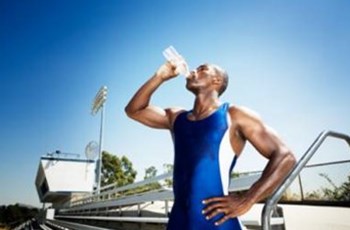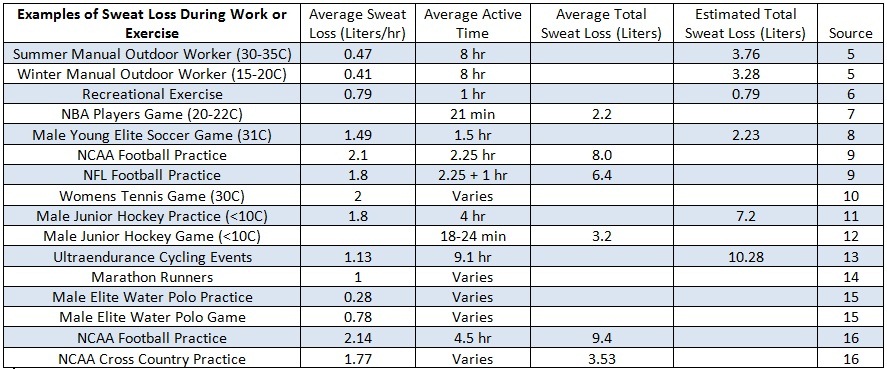
While working or exercising, do you sweat for an extended period of time? Are you constantly exposed to a hot or humid environment? Do you take pre or post workout supplements and/or a multivitamin to replenish key nutrients lost during exercise? Are you aware that excessive perspiration has been linked to iodine deficiency?
Thyroid hormones, thyroxine (T4) and triiodothyronine (T3), are manufactured in the thyroid gland using iodine. Iodine consumed in the diet circulates in the bloodstream and is selectively taken up by the thyroid gland where, through a series of complex biochemical reactions, it is attached to tyrosine and eventually incorporated in the thyroid hormones T4 and T3.
These thyroid hormones are stored in the thyroid gland until a chemical signal from the pituitary gland, Thyroid Stimulating Hormone (TSH), activates their release into circulation. Once in the cell, thyroid hormones help to regulate metabolism and create energy and body heat.
When thinking about thyroid hormones and athletic performance, you should first think about energy and its importance in athletic events. Hallmarks of thyroid deficiency are fatigue and low stamina, not something you want to find yourself plagued with at the starting block. Every movement our body makes along with every thought process we have requires energy. Thyroid hormones play an important role in how our body creates and uses this energy. Excessive sweating through exercise can leave you with less than adequate body stores of iodine, along with increased risk for thyroid deficiency and the potential for poor athletic performance. This scenario can be compounded further for athletes on restricted or unbalanced low iodine diets that do not replenish the already low levels of body iodine caused by excessive sweating.
A 1945 study (1) was one of the first to show how hot and humid environments cause increased loss of iodine through sweat. Five males were shown to lose 2.3 times more iodine through sweat during an 8 hour period at 38.3oC (100.9oF) at 69% humidity than at 28.9oC (84.0oF) at 50% humidity. The net body weight loss was 92 g/hr at 28.9oC and 676 g/hr at 38.3oC. This study demonstrated that those exposed to hot and humid environments, even without exercise, can lose a greater amount of sweat, resulting in a greater iodine loss than those exposed to cooler and less humid temperatures.
Two later studies targeted student athletes to determine iodine loss from sweat, comparing them to sedentary students. Rowing club students were the focus in 1985 (2), and it was determined that during two hours of exercise students were losing up to an estimated four liters of sweat. Based on an average sweat iodine concentration of 37 µg/L, up to 150 µg iodine per row session was lost. Urinary iodine levels of the rowing club students, an index of iodine consumption, were only 42% of the levels in sedentary students. A similar study was completed in 2001 (3) that compared 13 soccer student athletes to 100 sedentary students. The results were shocking. Low urine iodine (<50 µg/g creatinine) was found in 38.5% of soccer players but only 2% of sedentary students. Goiter, a clinical sign of chronic iodine deficiency, was present in 46% of the soccer players but only 1% of sedentary students. During one hour of soccer, 38% of players lost more iodine through sweat than excreted in urine the entire day.
Another study completed in 1990 (4) collected sweat from Korean soccer players during a one hour game period. The soccer players had been rigorously training for six months leading up to the study. Mean sweat loss was 1.54 L/hr with an average sweat iodine concentration of 37 µg/L, meaning they were losing about 57 µg of iodine every hour of practice. Six of the 13 soccer players were diagnosed with goiter.
Athletes performing at high intensity for prolonged periods of time, particularly in a humid environment, have significantly increased risk of becoming iodine deficient if they don’t pay special attention to replacing this important nutrient through diet, iodine-containing nutritional supplements, or iodized salt. The Table below provides a rough estimate of the average sweat loss, and thus risk for iodine deficiency, for different groups participating in physically challenging non-athletic and athletic events.
Each study shows that individuals who sweat excessively can be at risk for iodine deficiency if they do not pay special attention to replenishing iodine lost in sweat. A 2005 review of exercise and sweat loss (17) used a crude calculation to demonstrate that over a 10 week training period an athlete can lose over 5 mg (5000 µg) of iodine, averaging about 70 µg/day. Individuals not consuming the recommended daily intake of at least 150 µg iodine (18) would, therefore, more likely suffer the consequences of iodine deficiency disorders which include fatigue, low energy, low stamina, and poor athletic performance.
We believe that special attention should be paid to replenishing urinary iodine levels in athletes whose performance results in excessive sweating. Since the current iodine status of an individual can be determined easily with urine, iodine testing should be included in health monitoring of these individuals to identify and correct iodine deficiency before it compromises athletic performance and overall health.
Related Resources
- Blog: Got Iodine? How to Get Enough Iodine through Your Diet.
- Download: Iodine Testing in Dried Urine
- Web: Toxic Heavy Metals & Elements
References
Spector H, Mitchell HH, Hamilton TS. The effect of environmental temperature and potassium iodide supplementation on the excretion of iodine by normal human subjects. J Biol Chem. 1945;161:137-43.
- Suzuki M, Tamura T. Iodine intake of Japanese male university students: urinary iodine excretion of sedentary and physically active students and sweat iodine excretion during exercise. J Nutr Sci Vitaminol (Tokyo). 1985 Aug;31(4):409-15.
- Mao IF, Chen ML, Ko YC. Electrolyte loss in sweat and iodine deficiency in a hot environment. Arch Environ Health. 2001 May-Jun;56(3):271-7.
- Mao IF, Ko YC, Chen ML. The stability of iodine in human sweat. Jpn J Physiol. 1990;40(5):693-700.
- Bates GP, Miller VS. Sweat rate and sodium loss during work in the heat. J Occup Med Toxicol. 2008 Jan 29;3:4.
- Peacock OJ, Stokes K, Thompson D. Initial hydration status, fluid balance, and psychological affect during recreational exercise in adults. J Sports Sci. 2011 Jun;29(9):897-904.
- Osterberg KL, Horswill CA, Baker LB. Pregame urine specific gravity and fluid intake by National Basketball Association players during competition. J Athl Train. 2009 Jan-Feb;44(1):53-7.
- Da Silva RP, Mündel T, Natali AJ, Bara Filho MG, Alfenas RC, Lima JR, Belfort FG, Lopes PR, Marins JC. Pre-game hydration status, sweat loss, and fluid intake in elite Brazilian young male soccer players during competition. J Sports Sci. 2012 Jan;30(1):37-42. Epub 2011 Nov 23.
- Godek SF, Bartolozzi AR, Peduzzi C, Heinerichs S, Garvin E, Sugarman E, Burkholder R. Fluid consumption and sweating in National Football League and collegiate football players with different access to fluids during practice. J Athl Train. 2010 Mar-Apr;45(2):128-35.
- Tippet ML, Stofan JR, Lacambra M, Horswill CA. Core temperature and sweat responses in professional women's tennis players during tournament play in the heat. J Athl Train. 2011 Jan-Feb;46(1):55-60.
- Palmer MS, Spriet LL. Sweat rate, salt loss, and fluid intake during an intense on-ice practice in elite Canadian male junior hockey players. Appl Physiol Nutr Metab. 2008 Apr;33(2):263-71.
- Logan-Sprenger HM, Palmer MS, Spriet LL. Estimated fluid and sodium balance and drink preferences in elite male junior players during an ice hockey game. Appl Physiol Nutr Metab. 2011 Feb;36(1):145-52.
- Armstrong LE, Casa DJ, Emmanuel H, Ganio MS, Klau JF, Lee EC, Maresh CM, McDermott BP, Stearns RL, Vingren JL, Wingo JE, Williamson KH, Yamamoto LM. Nutritional, physiological, and perceptual responses during a summer ultraendurance cycling event. J Strength Cond Res. 2012 Feb;26(2):307-18.
- Noakes TD, Myburgh KH, du Plessis J, Lang L, Lambert M, van der Riet C, Schall R. Metabolic rate, not percent dehydration, predicts rectal temperature in marathon runners. Med Sci Sports Exerc. 1991 Apr;23(4):443-9.
- Cox GR, Broad EM, Riley MD, Burke LM. Body mass changes and voluntary fluid intakes of elite level water polo players and swimmers. J Sci Med Sport. 2002 Sep;5(3):183-93.
- Godek SF, Bartolozzi AR, Godek JJ. Sweat rate and fluid turnover in American football players compared with runners in a hot and humid environment. Br J Sports Med. 2005 Apr;39(4):205-11; discussion 205-11.
- Smyth PP, Duntas LH. Iodine uptake and loss-can frequent strenuous exercise induce iodine deficiency? Horm Metab Res. 2005 Sep;37(9):555-8.
- WHO, UNICEF, ICCIDD. Assessment of iodine deficiency disorders and monitoring their elimination; a guide for programme managers, 3rd ed. WHO Publications: Geneva, 2007.

